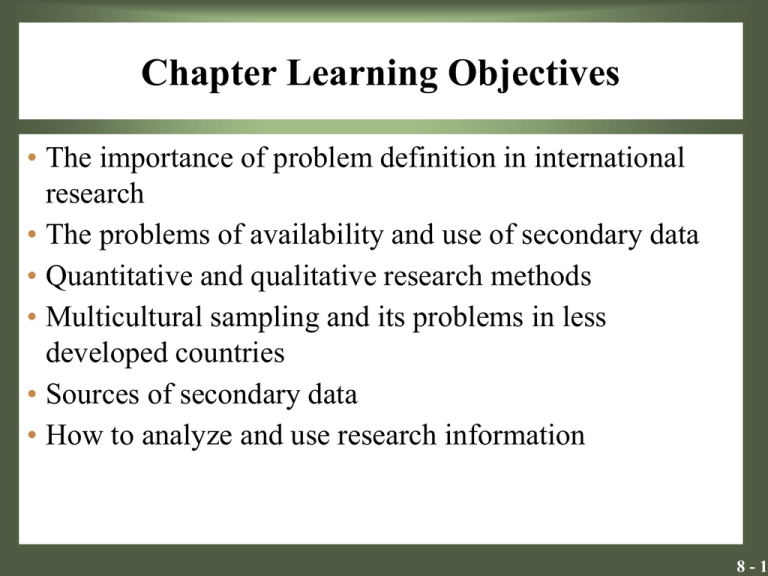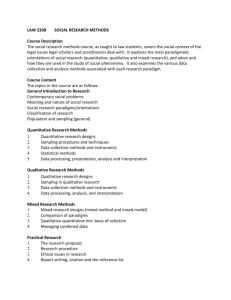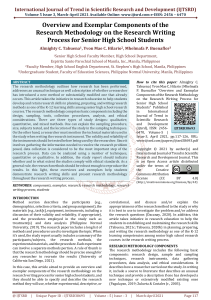Research
advertisement

Chapter Learning Objectives • The importance of problem definition in international research • The problems of availability and use of secondary data • Quantitative and qualitative research methods • Multicultural sampling and its problems in less developed countries • Sources of secondary data • How to analyze and use research information 8-1 The Research Process • The research process should follow these steps: 1. Define the research problem and establish research objectives 2. Determine the sources of information to fulfill the research objectives 3. Consider the costs and benefits of the research effort 4. Gather the relevant data from secondary or primary sources, or both 5. Analyze, interpret, and summarize the results 6. Effectively communicate the results to decision makers • Although the steps in a research program are similar for all countries, variations and problems in implementation occur because of differences in cultural and economic development. 8-2 Defining the Problem and Establishing Research Objectives • The major difficulty is converting a series of often ambiguous business problems into tightly drawn and achievable research objectives. • The first, most crucial step in research is more critical in foreign markets because an unfamiliar environment tends to could problems definition. • Other difficulties in foreign research stem from failures to establish problem limits broad enough to include all relevant variables. 8-3 Problems of Availability and Use of Secondary Data • Availability of data - Most countries simply do not have governmental agencies that collect on a regular basis the kinds of secondary data readily available in the U.S. - Researchers’ language skills • Reliability of data - Official statistics are sometimes too optimistic, reflecting national pride rather than practical reality, while tax structures and fear of the tax collector often adversely affect data. • Comparability of data - In other countries, especially those less developed, data can be many years out of date as well as having been collected on an infrequent and unpredictable schedule. - Too frequently, data are reported in different categories or in categories much too broad to be of specific value. 8-4 Problems of Availability and Use of Secondary Data (cont’d) • Validating secondary data - Questions should be asked to effectively judge the reliability of secondary data sources: • Who collected the data? Would there be any reason for purposely misrepresenting the facts? • For what purposes were the data collected? • How were the data collected? • Are the data internally consistent and logical in light of known data sources or market factors? • Checking the consistency of one set of secondary data with other data of known validity is an effective and often-used way of judging validity. • The availability and accuracy of recorded secondary data increase as the level of economic development increases. 8-5 Gathering Primary Data: Quantitative and Qualitative Research • Primary data – Data collected specifically for the particular research project at hand. • Quantitative research – Usually a large number of respondents are asked to reply either verbally or in writing to structured questions using a specific response format (such as yes/no) or to select a response from a set of choices. - Toto in Japan • Qualitative research – If questions are asked, they are almost always open-ended or in-depth, and unstructured responses that reflect the person’s thoughts and feelings on the subject are sought. • Qualitative research seeks to interpret what the people in the sample are like. • Qualitative research is helpful in revealing the impact of sociocultural factors on behavior patterns and in developing research hypotheses. 8-6 Problems of Gathering Primary Data • Ability to communicate opinions - It is difficult for a person to formulate needs, attitudes, and opinions about goods whose use may not be understood, that are not in common use within the community. • Gerber • Willingness to respond - Cultural differences - The role of the male, the suitability of personal gender-based inquiries, and other gender-related issues can affect willingness to respond. • Sampling in field surveys - The greatest problem in sampling stems from the lack of adequate demographic data and available lists from which to draw meaningful samples. 8-7 Problems of Gathering Primary Data (cont’d) • The kinds of problems encountered in drawing a random sample include the following: - No officially recognized census of population No other listings that can serve as sampling frames Incomplete and out-of-date telephone directories No accurate maps of population centers • Language and comprehension - The most universal survey research problem in foreign countries is the language barrier. - Literacy poses yet another problem - Marketers use three different techniques to help ferret out translation errors ahead of time. • Back Translation • Parallel Translation • Decentering 8-8 Multicultural Research: A Special Problem • As companies become global marketers and seek to standardize various parts of the marketing mix across several countries, multicultural studies become more important. • Multicultural research involves dealing with countries that have different languages, economies, social structures, behavior, and attitude patterns. • In some cases the entire research design may have to be different between countries to maximize the comparability of the results. 8-9 Problems in Analyzing and Interpreting Research Information • Accepting information at face value in foreign markets is imprudent. • The foreign market researcher must posses three talents to generate meaningful marketing information. - First, the researcher must posses a high degree of cultural understanding of the market in which research is being conducted. - Second, a creative talent for adapting research methods is necessary. - Third, a skeptical attitude in handling both primary and secondary data is helpful. 8 - 10 Summary • The basis objective of the market research function is providing management with information for more accurate decision making. • Customer attitudes about providing information to a researcher are culturally conditioned. • Foreign market information surveys must be carefully designed to elicit the desired data and at the same time not offend the respondent sense of privacy. 8 - 11 Summary (continued) • Many foreign markets have inadequate or unreliable bases of secondary information • Three keys to successful international marketing research: - The inclusion of natives of the foreign culture on research teams - The use of multiple methods and triangulation - The inclusion of decision makers, even top executives, who must on occasion talk directly to or directly observe customers in foreign markets 8 - 12











